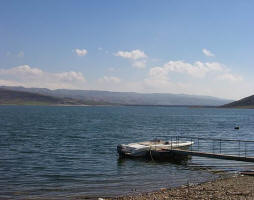 Desalination in the Mediterranean region: Cumulative environmental impacts revealed by a recent assessment
Desalination in the Mediterranean region: Cumulative environmental impacts revealed by a recent assessment
A recent study realized by SWIM-SM assesses the current installed capacity and prospects of desalination until 2023. It also investigates the cumulative environmental impacts of mega desalination plants conglomerating around the Mediterranean Sea.
In fact, in most South Mediterranean countries, there is growing concern that the available freshwater resources are now facing or will soon encounter severe chronic shortages that might make life difficult and among the solutions envisaged by countries is to produce freshwater by desalinating salt water.
Desalination plants have been built since several decades at various scales in almost all Mediterranean countries. Recent advances in technology have made it an economically viable - and therefore even more appealing – alternative source of freshwater: the reported installed capacity has dramatically increased between 2000 to 2013 by an astounding 560 %. Spain has the highest installed cumulative capacity of 3.7 Million m3 /day, followed by Algeria and Israel, with respective daily production of 2.4 Million m3/day and 2.1 Million m3/day.
However, beside its important benefits, seawater desalination also has impacts associated with the intakes, outfalls and energy consumption.
Based on current (2013) data, here are some of the predictions made in the assessment about the future situation:
- By 2030 the large volume of seawater to be withdrawn at the desalination plants intakes might pose a serious threat to the near-shore marine environment known for its importance as a habitat for diversity of marine aquatic lives. Depletion of near-shore marine life may represent the most significant direct adverse effect of seawater desalination.
- By 2030 the total CO2 emission is predicted to range between 38 to 50 million metric tons/year. The total CO2 emitted from desalination of Mediterranean Sea water in 2013 (15 million metric tons) was equivalent to putting 3.3 Million new cars on the roads or burning a volume of petrol slightly over 24 Million liters/day.
- Despite the fascination of water planners with Renewable Energy (RE) in desalination, it is projected that desalination by concentrated solar power (CSP) will take a couple of decades before replacing the currently operating fossil fuel desalination plants in the region.
- By 2030 the amount of chemicals released into the sea is not expected to increase considerably or, in the best case scenario (linked to the use of advanced desalination technologies) to even decrease if compared with 2013 data.
- Shallow and relatively stagnant nearly-land-locked coastal areas such as bays, harbors etc. and their marine life will bear most of the impacts related to brine and chemicals discharge.
The study also provides a simple nine steps methodology to assess the cumulative impacts of desalination plants, which were never assessed or foreseen before in the Mediterranean Sea also due the lack of integrated information systems and networks.
| Contact information | n/a |
|---|---|
| News type | Inbrief |
| File link |
http://www.swim-sm.eu/files/Environmental_Impacts_of_Desalination.pdf |
| Source of information | SWIM-SM |
| Keyword(s) | desalination |
| Subject(s) | ANALYSIS AND TESTS , CHARACTERISTICAL PARAMETERS OF WATERS AND SLUDGES , DRINKING WATER , DRINKING WATER AND SANITATION : COMMON PROCESSES OF PURIFICATION AND TREATMENT , ENERGY , FINANCE-ECONOMY , HYDRAULICS - HYDROLOGY , INDUSTRY , INFORMATION - COMPUTER SCIENCES , INFRASTRUCTURES , MEASUREMENTS AND INSTRUMENTATION , NATURAL MEDIUM , POLICY-WATER POLICY AND WATER MANAGEMENT , RISKS AND CLIMATOLOGY , SANITATION -STRICT PURIFICATION PROCESSES , SLUDGES , TOOL TERMS , TOURISM - SPORT - HOBBIES , WATER DEMAND , WATER QUALITY |
| Relation | http://www.emwis.net/topics/Desalination |
| Geographical coverage | Spain, Algeria, Israel |
| News date | 03/06/2015 |
| Working language(s) | ENGLISH |
 you are not logged in
you are not logged in





